costa rica Vacation for Adventure, Relaxation and that pura vida
Are you planning on traveling to Costa Rica for both relaxation and a little adventure? And to experience that ‘pura vida’?
Well this blog will give you lots of tips on where to stay, how to get around, and what activities you should try while vacationing in Costa Rica. But first, some fun facts! Did you know:
- Costa Rica covers only 0.03% of the world’s surface but contains 6% of its biodiversity
- There are 200 volcanoes, making it a prime spot for geothermal energy production…and hot springs!
- Costa Rica has no military presence (no army or navy)
- The sloth is the National animal of Costa Rica (as of summer 2021!)
- Costa Rica was built on coffee- the grano de oro or ‘golden grain’
- It’s the birthplace of eco-tourism!
What is pura vida
One of the first sayings you might hear in Costa Rica is ‘pura vida’. Pronounced POUR-A-VEEDA, it literally translates to the pure life. So, living the simple life is a key component to happiness in Costa Rica.
Whether you are a local, or a traveler. You will hear it as a greeting in the morning, as an answer to how is your day, or before you go to sleep at night.
If you typically lead a fast-paced, hectic life, then enjoy the pura vida found in Costa Rica. Slow down and enjoy reading by the beach. Sleep in. Eat fresh fruit with every meal. Enjoy the monkeys howling in the trees!
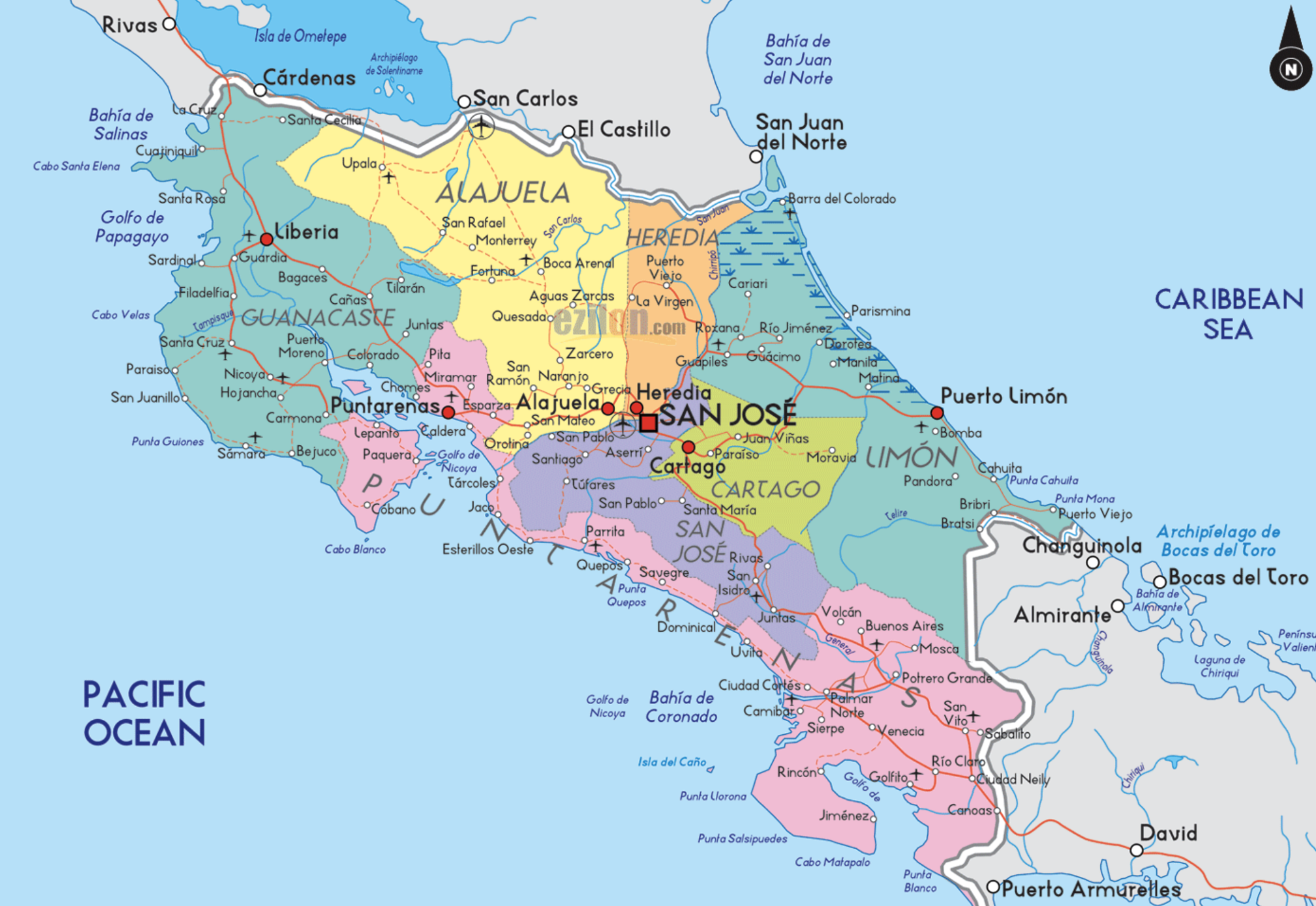
best places to visit in Costa Rica
The country of Costa Rica is about the size of West Virginia. So it is possible to visit more than one region during your trip!
However, keep in mind, most of the driving in Costa is on smaller roads, even dirt roads. Speeds in your rental car will barely top 50mph! So, although some distances appear close, it could take hours to reach them. More on renting a car in a bit!
As you can see in the map above, Costa Rica is divided into 7 provinces: Guanacaste, San José, Alajuela, Heredia, Limón, Puntarenas, and Cartago. The majority of travelers visit Guanacaste and Puntarenas for the beaches, followed by Alajuela for the volcanos!
Here’s some of the most popular towns/areas you may want to visit within those regions:
Guanacaste
- Rincon de la Vieja volcano
- Tamarindo, Playa Langosta, and Playa Grande
- Papagayo- a newly developed area with lots of all-inclusives
- Playa Guiones, Samara, and smaller beach towns along the Nicoya Peninsula
ALajuela:
- Arenal Volcano and the town of Fortuna
- Monteverde Cloud Forest
Puntarenas:
- Santa Teresa- Southern tip of the Nicoya Peninsula
- Jaco- touristy beach area
- Quepos and Manuel Antonio National Park
- The Osa Pennisula
Flying in To Costa Rica: Which Airport Should You Choose?
The 2 main airports you’ll fly into from the U.S. are either Liberia or San Jose. Traveling to anywhere in the Guanacaste province? Book your flights into Liberia International Airport (LIR).
Traveling to the Puntarenas province, Arenal, the Caribbean, or destinations south? Then look for flights into the airport in San José (SJO). San José is the larger of the 2 airports, located in Costa Rica’s capital city. And it serves more airlines with many more international flights per day.
In addition, you can also find connecting flights in San José to reach places like Santa Teresa (Tambor Regional Airport) on the Nicoya Peninsula.
Many U.S.-based airlines now fly to Costa Rica, including Southwest, Alaska, Delta and others. International airlines that fly from Canada and Mexico into Costa Rica include Copa, Air Canada, and Mexicana. And finally for travel within Costa Rica, check out Sansa.
As for rental cars, if you’re planning to stay in one town, you will not need a rental car. Instead rent bikes or quads! Take a taxi or a pedi-cab. Most towns will have quads or bike rentals available.

best time of year to visit costa rica
Costa Rica is a beautifully lush country any time of year! The rainy season is from May through December. And the dry season from mid-December through April.
The dry season is also when you will find the highest prices on accommodations and airfare. And the most tourists.
Keep in mind, like most other tropical destinations, most days during the rainy season it may only rain for an hour or two. This leaves you with plenty of sunshine for the rest of your day’s activities!
top things to do in costa rica
Believe it or not, not everyone comes to Costa Rica to surf. Although Costa Rica is indeed a major surf trip destination, there’s so many other activities that you may find it hard to choose what to do each day!
Here are our Top Things to Do in Costa Rica:
1. Mountain biking
Renting a bike or a quad is a great way to get around small towns in Costa Rica. But did you know well-maintained mountain bike trails exist near some of the coastal towns like Tamarindo and Playa Guionies as well as up in the mountains?
Check out Nosara MTB in Playa Guiones adjacent to one of our favorite hotels, the Gilded Iguana Hotel, for rentals. There’s even a bike park here in town!
In Tamarindo, try one of the local guide shops for bike rentals. Or Pura Vida Ride, which is about 40 minutes south of Tamarindo, will have more higher end mountain bikes and have a nice trail system nearby.
Visiting Rincon de la Vieja? They have a wonderful trail system that takes you to waterfalls, hot springs, and with views of the volcano. We loved the mountain bike rentals and the trails around the Hacienda Guachipelín!
2. Snorkeling or Scuba Diving
Not all of Costa’s rich biodiversity is found on land. Some of the best snorkeling and scuba diving in Costa Rica is easily accessible by organizing a full day or half day boat trip.
Costa Rica’s most stunning underwater areas include:
- Isla Catalina
- Cahuita National Park on the Caribbean
- Isla Murciélagos at the tip of Santa Rosa National Park
- Isla Tortugas in Puntarenas, closest to Santa Teresa
Read more about the best snorkeling and diving from Culture Trip!
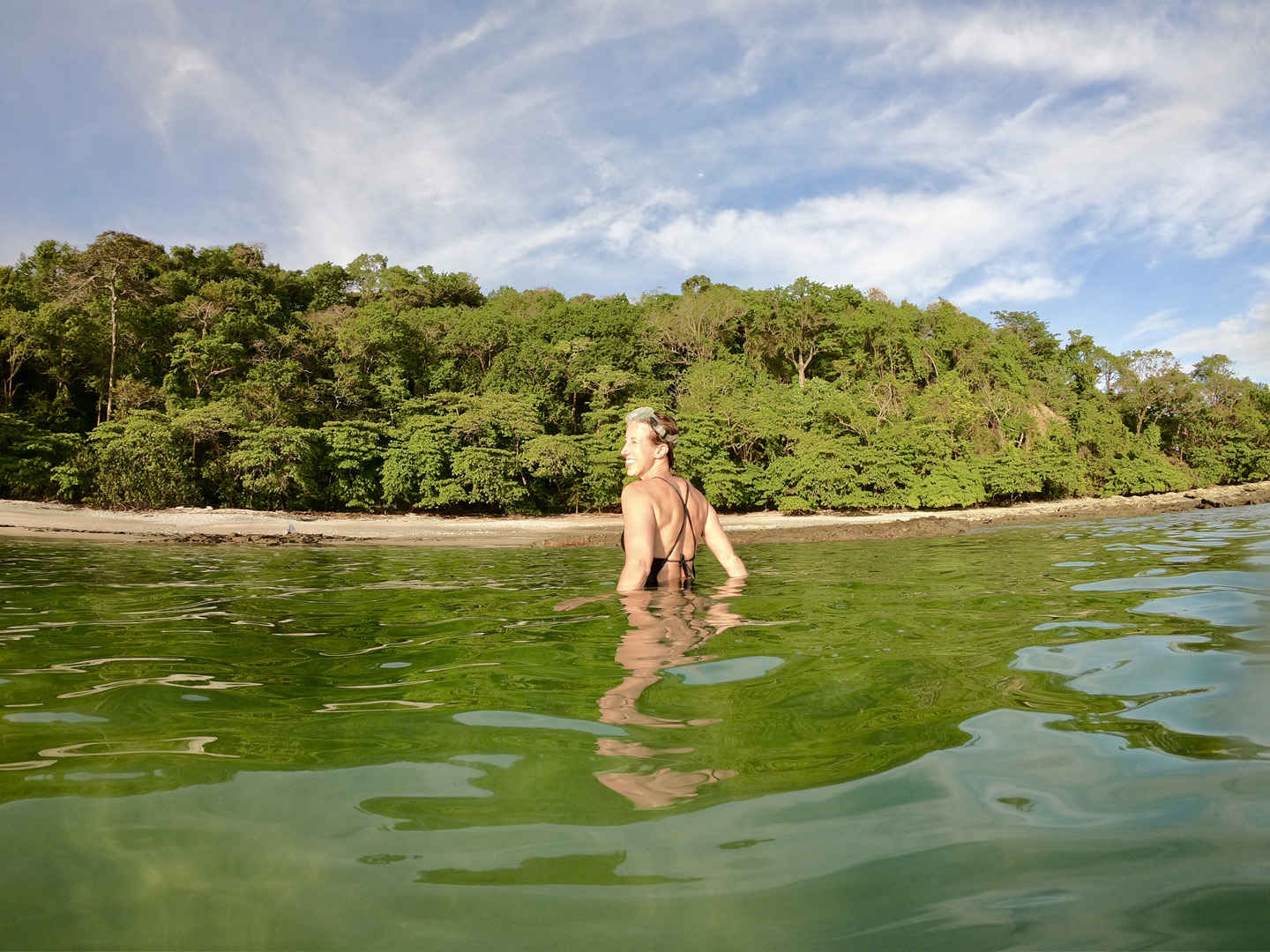
3. Sign up for a Yoga Class
Yogis flock to Costa Rica to flex, stretch, and purify their bodies. And many hotels will have yoga studios, or ‘yoga decks’ overlooking the ocean!
Two of our favorites were in Santa Teresa at Florblanca and Pranamar Oceanfont Villas and Yoga Retreat.
Be prepared to pay at least $12-30 a class, purchase a package, or stay at a yoga retreat center. Check out these other incredible options for a yoga retreat!
4. Book a Massage or spa Retreat
Treat yourself in Costa Rica, especially after a hard day of surfing or ziplining through the jungle, to a rejuvenating massage. There are an abundance of spas and massage therapists available. From your high enter luxury to low-budget or eco-friendly.
Our favorites include El Silencio de Campo, a spa and resort surrounded by the jungle with thermal pools and volcano views. Located in Fortuna near the Arenal Volcano, spend a day or two here if you can!
Another nice but pricer option nearby is Tabacón Thermal Resort and Spa. Indulge in the largest network of flowing mineral springs in Costa Rica!
Heading to the south? Try the Gaia Hotel and Nature Reserve in Quepos near Manuel Antonio National Park.
5. hang with the howler monkeys
If you’ve never heard the call of a howler monkey, you’re in for a treat. Howler monkeys make an incredibly loud yet haunting sound, and their calls can travel up to 2-3 miles through the dense rainforest habitat!
There are 15 different species of howler monkeys, and they’re about 2-3ft. in length, not including their tails. You will usually find a family of 6-15 howler monkeys all together in the trees! Typically one large adult male and females with babies.
In this incredibly biodiverse landscape, you will not only find howler monkeys in the trees, but dozens of species of birds, butterflies, sloths, iguanas and so many more creatures that call Costa Rica home.
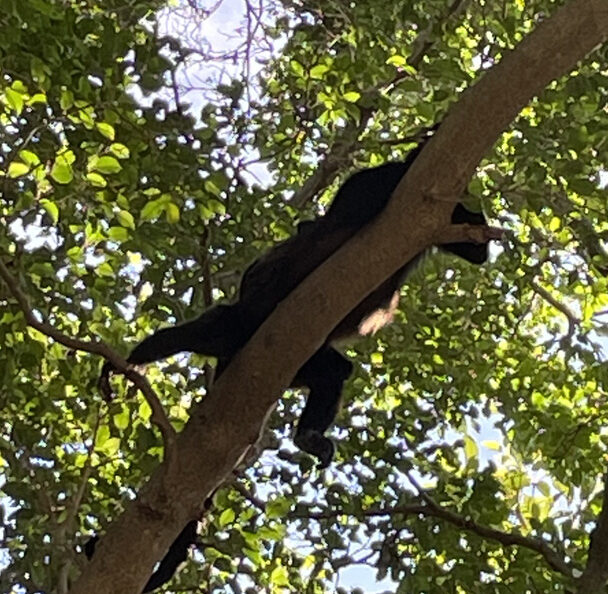
6. Take a hike or trail run through the jungle
There are dozens of beautiful hiking trails around both the Arenal Volcano and Rincon de la Vieja Volcano. You can also hike to one of the many waterfalls, read more about that below, or just take it easy and hike along the coast.
Go in the morning or just before sunset for your best chance of seeing and hearing the howler monkeys!
Check out All Trails for more specifics, but here’s a few things to keep in mind when hiking in the jungles of Costa Rica: it will be warm and humid. So in addition to wearing sunblock, bug spray, and good hiking shoes that dry fast, make sure to bring plenty of water and a hat! Lastly, always go with a buddy and with plenty of daylight ahead of you.
7. Visit the waterfalls or cataratas in costa rica
Many of the best hiking trails in Costa Rica will lead to gorgeous waterfalls. And we always carry a packable quick-drying towel for those impromptu moments! A few we love include:
- La Fortuna Waterfall near Arenal
- Rio Celeste Waterfall in Tenorio Volcano National Park (near Lake Arenal)
- Montezuma Waterfall outside of the town of Montezuma near Santa Teresa
- Chorreras Waterfall, Oropendola Waterfall, and Victoria Waterfall all on the sprawling grounds of the Hacienda Guachipelín!
Signage for the waterfalls may say ‘catarata’ or ‘cascada’, which is Spanish for waterfall. Visiting during the rainy season? Be aware of flash floods, expect muddy water, and watch out for debris moving swiftly downstream. Oh and crocodiles!
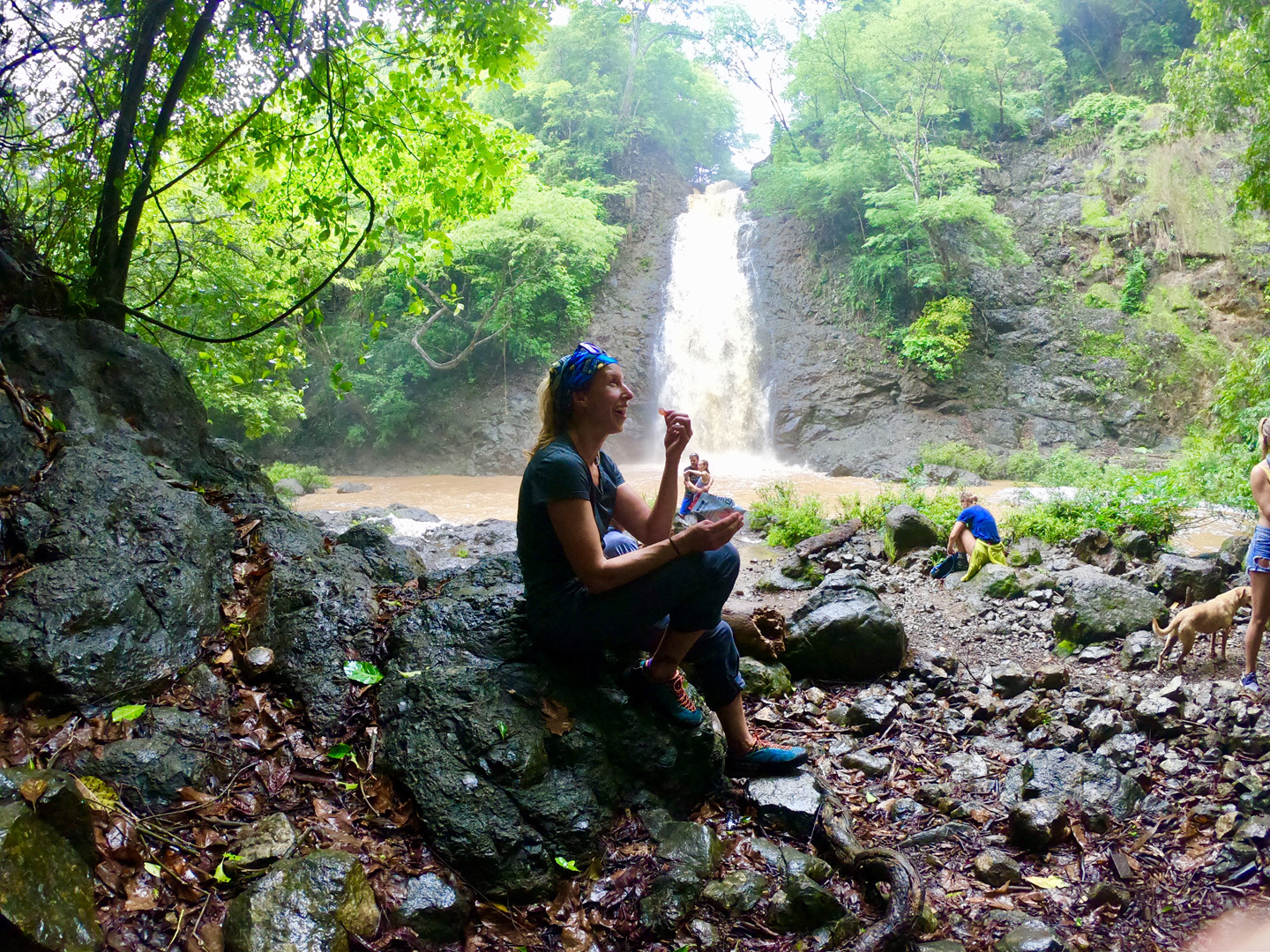
8. take a crocodile tour through the mangroves
Did you know Costa Rica is home to crocodiles? Yes! Two species, the American Crocodile and the Caiman. If you’re heading towards Jaco, you can see dozens of crocodiles from the Tarcoles River Bridge!
In the Tamarindo area? Get a guide and spend the morning in the estuary exploring the mangroves just inland from the coast. Not only will you see crocodiles, but also dozens of species of birds, and even howler monkeys!
It is not safe to hike or SUP on your own along riverbanks or swim in rivers where crocodiles may be present. So a tour guide or an estuary boat tour is the way to go. One Costa Rica tour guide company we loved was Native’s Way!
9. watch sea turtles nesting
One of the most unique adventures you can have traveling in Costa Rica is to watch sea turtles nesting. You might also catch baby sea turtles making their way out to sea. The nesting or egg-laying process can happen with hundreds of sea turtles all coming ashore at the same time. These are called arribadas and are just incredible to watch!
As someone who studied marine biology for years, seeing a sea turtle in real life is pretty special. And since all 7 species of sea turtles are endangered, it’s even more humbling to watch them crawl up onto the beach under the cloak of darkness, dig a hole in the sand, and lay their eggs.
Why are sea turtles endangered? Sea turtles are often tracked and killed for their eggs, meat, and their shell. And then there’s habitat destruction and climate change…but I digress. However, sea turtle poaching or exploitation is taken very seriously in Costa Rica, where eco-tourism originally began.
Therefore, if you want to get up close with a sea turtle, support one of the local tour guides and book a truly one-of-a-kind experience. We worked with Native’s Way in Tamarindo and visited Las Baulas National Marine Park near Playa Grande!
But if you happen to be on your own, Costa Rica’s National Parks, or quieter beaches that do not have as many people or light pollution are great spots for sea turtle hatching or nesting.
Types of Sea Turtles in Costa Rica
There are several different species of sea turtles that you might see in Costa Rica, and below are the areas they can be found and the best times to see them:
Olive Ridley sea turtle– The Ostional Wildlife Refuge or Ostional Beach on the Nicoya Peninsula is the largest of 2 locations in Costa Rica where there is an annual arribada.
Just north of Playa Guiones, hundreds of olive ridley sea turtles come ashore at Ostional to lay their eggs just before the new moon. Visit September through October for the best chance of seeing an Olive Ridley sea turtle arribada.
Green sea turtle- Green sea turtles are primarily found on the Caribbean side of Costa Rica in Tortuguero National Park near Limón. And, Tortuguero is the largest nesting site for green sea turtles in the Western Hemisphere! Visit July through mid-October.
Leatherback sea turtle– Leatherback or Las Baulas in Spanish, and is also the name of the National Marine Park where you can find leatherback sea turtles.
Just north of Tamarindo near Playa Grande, Las Baulas National Marine Park is a prime nesting site for the world’s largest sea turtle! Visit the Caribbean February through June, or Playa Grande October through February.
Hawksbill sea turtles and Loggerhead sea turtles- You may find Loggerheads nesting on the Caribbean side and Hawksbill sea turtles on the Pacific side of the country, however, these are the rarest species.
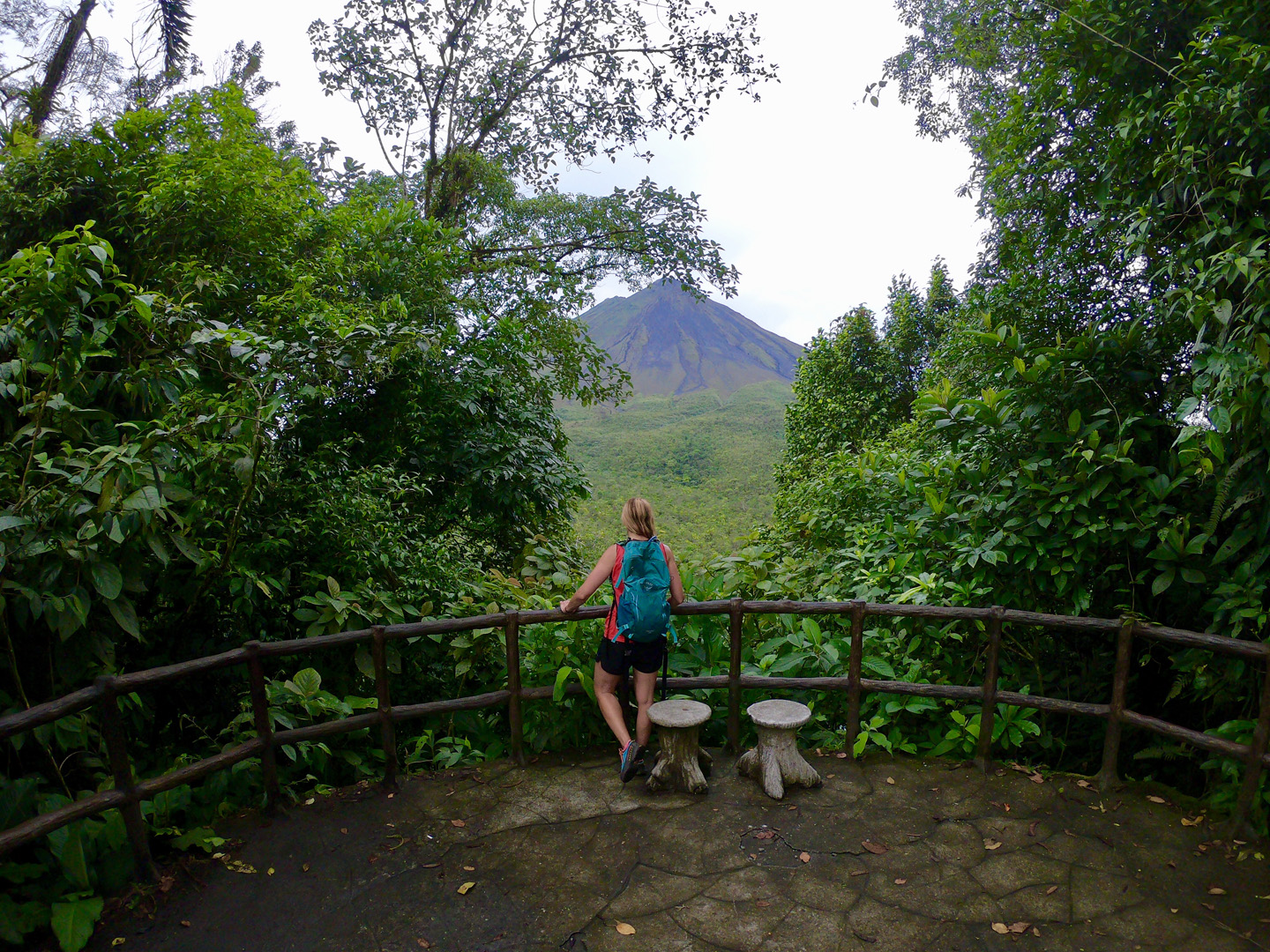
10. visit the hot springs and take a mud bath
Costa Rica has an extraordinary amount of geothermal activity. There are almost 200 volcanos!
And most of the country’s energy, over 95%, is either geothermal or hydroelectric. Talk about using your renewable resources! If you’re really into learning more, we loved the Green Policy platform’s article Full Steam Ahead: Tapping into Costa Rica’s Geothermal Energy.
So while you’re traveling in Costa Rica, visit one of the many hot springs or thermal pools. Often you’ll find these nearest volcanos including Arenal and Rincon de la Vieja.
In addition, there are several resorts where the hot springs percolate through the property, warming small secluded pools at different temperatures.
Lastly, while at most hot springs, you’ll have the opportunity to take a mud bath…do it! The rich minerals contained in the mud help alleviate tension, calm skim conditions, decrease stress, and soothe sore muscles. Here are a few places we loved for mud baths and hot springs:
- El Silencio de Campo, a resort surrounded by the jungle with thermal pools and a view of Arenal
- Tabacón Thermal Resort and Spa, also near Arenal, it boast the largest network of flowing mineral springs
- Hacienda Guachipelín, located at Rincon de la Vieja, this was our favorite place for almost every activity except surfing!
11. try ziplining through costa rica’s rainforest
One of the most exhilarating ways to see and experience life high up in the rainforest tree canopy is by zip-lining. And, you do not need any experience to try zip-lining in Costa Rica.
Just be comfortable walking up stairs, and get ready to enjoy a bit of high flying way above the jungle floor!
Most of the tourist areas will have zipline canopy tours nearby. In addition, some tour companies will combine a zipline tour with a waterfall hike or a visit to the hot springs.

-12. visit a costa rica coffee plantation
It all started with coffee in Costa Rica, and the amazing biodiversity might have helped a little! So if you consider yourself a coffee connoisseur then your trip would not be complete without a visit to one of Costa Rica’s coffee plantations.
There’s a few different regions where coffee is grown, but mainly in the central mountainous area around the San José province. The largest coffee producing area in Costa Rica is Tarrazú, which is south of San José and close to the Cartago province. Here you’ll find higher elevations, rich volcanic soils, and cooler temperatures.
Skip the touristy coffee tastings, the ones in storefronts that aren’t really producing coffee at all, and visit a coffee plantation or farm, finca in Spanish.
Here’s a few smaller operations: Hacienda La Minita, the Finca Rosa Blanca Inn and Coffee Farm, or Aquiares.
Or you can read more about the top Costa Rica coffee Tours at some of the larger establishments. And if you don’t have enough room in your suitcase, brands like Britt can be easily purchased in the states through Amazon!
13. take a surf lesson
Well, we’ve saved the best for last and for those that have never tried surfing, Costa Rica is one of the best places to learn. There’s lots of beginner beach breaks with warm, gentle waves rolling across sandy bottoms. From surf camps, to surf retreats, to just a one hour surf lesson, here’s some of the best surf camps from AFAR!
During your lesson you will be given a longboard, most likely a foam board or softtop that’s about 8 feet or longer, and a rash guard to wear over your bathing suit. Beach towns like Jaco, Quepo, Tamarindo, Santa Teresa, Playa Guiones, and Papagayo also have plenty of surf shops where you can rent surfboards and go on your own.
If you’re an intermediate surfer, or only plan to surf for a few days out of your trip, it’s actually not a bad idea to leave your board at home and rent one. Places like the Gilded Iguana in Playa Guiones not only offer high quality surfboard rentals, they also have an entire Surf Club where you can grab a smoothie, rent a locker, store your board, and have a shower post surf session!
places to stay in costa rica
Need more ideas on where to stay in Costa Rica? We love renting Airbnb’s when we’re staying for a week or longer, or with a group of friends. However, here are a few gorgeous places that can accommodate both couples or a small group, and are away from the crowds!
- Surf Vista Villas in Santa Teresa is one of our favorites for a group trip!
- Gilded Iguana in Playa Guiones
- Playa Langosta’s Sueño del Mar –relaxation away from the crowd and conveniently located in walking distance to both surf breaks in Tamarindo (more beginner friendly), and Playa Langosta (more advanced)!
- In Playa Grande the Rip Jack Inn – great treetop bar and restaurant. There’s a good surf break out front, it’s walking distance to Las Baulas Marine Park, and you can book an estuary tour to see crocodiles!
Want to read more of our travel blogs for warm weather destinations?
- Cuba Libre: Travel Tips for Outdoor Adventurers in the land of Classic Cars and Cigars
- Oaxaca, Mexico Travel Guide
- Adventure Travel in Spain
Until next time, happy traveling and enjoy some pura vida wherever you are!
Meredith McConvill
Recent Comments